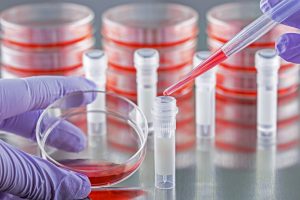Improve your flow cytometry sample prep for more reliable results
Sample material is precious, so it’s essential that flow cytometry data is both reliable and reproducible. This means optimizing every step of your flow cytometry protocol, beginning with sample prep, since a poor-quality sample can lead to catastrophic results downstream. Whatever cell type you’re studying, our top tips for sample prep will help you get the most out of your flow cytometry experiments.
Ensure cultured cells are healthy
Cultured cells are extremely sensitive to environmental factors such as temperature, pH, and humidity. For them to be suitable for flow cytometry experiments, it is therefore vital that CO2 incubators are well-maintained and not over-loaded, and that door opening is kept to a minimum. Cellular behaviors are also affected by confluence, making it important that cells remain in log-phase growth to prevent cell death that can lead to clumping. Where cells require passaging, avoiding harsh centrifugations and using gentle detachment reagents like Accutase® can help mitigate aggregation.
Check cell concentrations
As well as counting cells during routine propagation to confirm growth is occurring as expected, counting is essential to ensure sample consistency between experiments. Hemocytometers have largely been superseded by Coulter counter-based systems such as Bio-Rad’s TC20™ Automated Cell Counter for more reliable counting and the elimination of user-bias, but both manual and automated options are valuable tools for keeping samples within an optimal cell concentration range. Where too many cells are used, valuable events can be lost from analyses, whereas using too few cells can significantly extend run times.
Think about using a viability stain
Measuring the cell concentration in parallel with an assessment of viability is helpful to monitor cell health. It can also alert researchers to any harmful effects of sample preparation, allowing protocols to be adapted early on. Reagents such as Acridine Orange / Propidium Iodide (AO/PI) have become preferred alternatives to the widely-used Trypan Blue – which can be cytotoxic if used inappropriately – and are readily compatible with most automated counting systems.
Make sure any treatments are consistent
In many cases, cells require some form of treatment prior to flow cytometric analysis. This might be dosing with potential drug candidates, stimulating a particular enzyme, or inducing cytokine signaling pathways. Such treatments must be consistent between experiments for flow cytometry data to be useful, yet reagent additions can often involve a time-sensitive thawing step or pipetting of extremely low volumes. To improve experimental reproducibility, researchers often use dry, pre-formulated mixes of common activators like Beckman Coulter’s DURActive stimulation kits or introduce liquid handling systems into protocols.
Consider enriching rare cell populations
Where cells of interest are present in samples at only low abundance, it may be necessary to perform target enrichment. This can especially be useful when the aim of a flow cytometry experiment is to detect rare cell types such as circulating tumor cells or antigen-specific T cells in blood. One way of enriching a target cell type is to use antibodies conjugated to magnetic beads, a popular example being Miltenyi Biotec’s MACS® microbead technology.
Handle blood and tissue samples carefully
A main difference between working with cultured cells and working with blood and tissue material relates to how samples are collected. Blood and tissue are frequently obtained from large cohort studies over an extended time period, requiring that samples be preserved ahead of flow cytometric analysis. The variability associated with sample preservation can be reduced using specialized tissue storage reagents, freeze-drying, and preserving material at -80oC. Where tissues subsequently undergo mechanical dissociation, tissue-specific dissociation buffers like Miltenyi Biotec’s Tissue Dissociation Kits for gentleMACS™ Dissociators can be used to preserve epitopes.
Filter samples to remove clumps
Filtering samples through an appropriately-sized cell strainer is a quick and easy way of removing any clumps that might complicate downstream analysis or block the flow cytometer. Almost any flow cytometry protocol can benefit from filtering samples, while a quick check under a microscope will confirm that no clumps remain.
Prevent cells sticking to one another
Once you’ve produced your single-cell suspension, it’s important to keep the cells from sticking to each other. This means using a resuspension buffer free of Ca2+/Mg2+ and containing up to 2% protein. It can also be helpful to add a DNase to your samples to clear any released DNA that may cause clumps to form. Another point worth noting is that cells are able to bind to plasticware; using polypropylene tubes can help minimize binding to tube walls.
Plan ahead for immunostaining
Once you’ve prepared your sample, it’s important not to waste all that hard work by plowing ahead with a sub-optimal immunostaining protocol. Antibody selection and panel design are critical here – not only will you need to consider the compatibility of any antibodies that will be used for multiplexing, but you’ll also need to think about the spectral properties of the fluorophores to which your antibodies are bound. Fortunately, we’re here to help! Using FluoroFinder’s Spectra Viewer, you can quickly compare over 800 fluorochromes from all suppliers in one intuitive platform while FluoroFinder’s panel design tool enables you to design optimal multi-color flow cytometry experiments with the latest fluorochrome and antibody offerings across >100 suppliers. So now that you’ve optimized your sample prep, let us guide you through the next stage of your flow cytometry experiment. Try visiting our Panel Builder or our Spectra Viewer.





